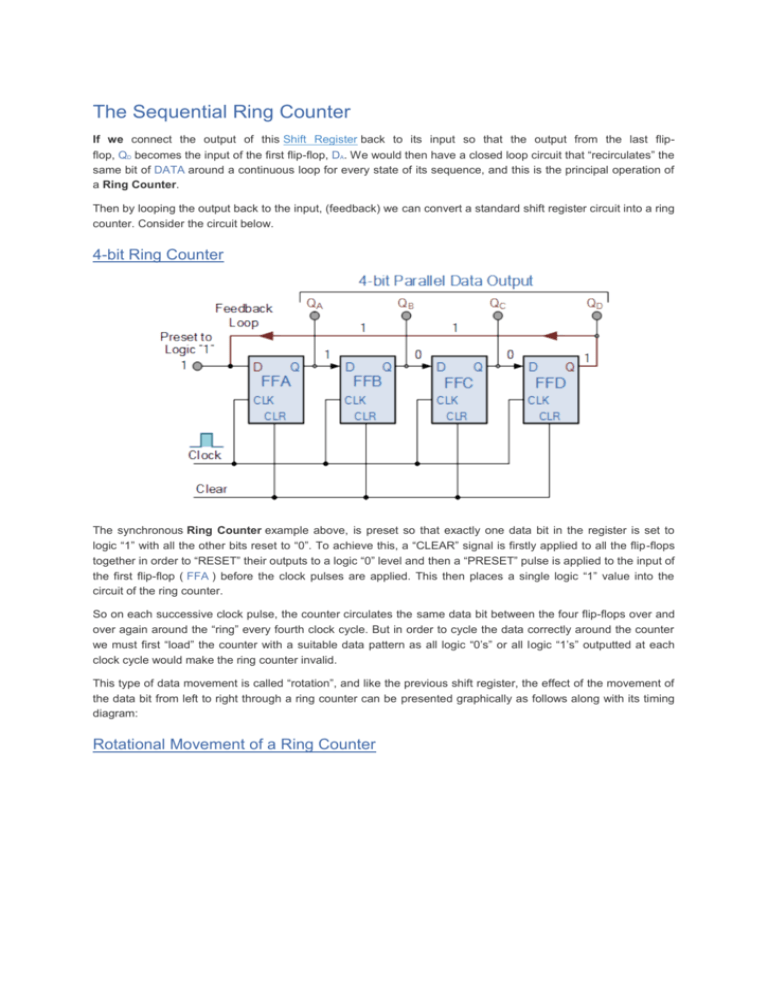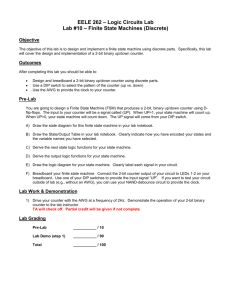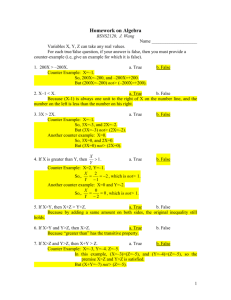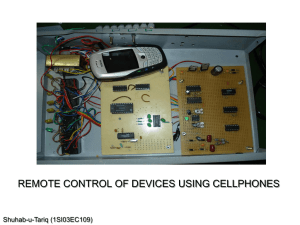Johnson Ring Counter
advertisement

The Sequential Ring Counter If we connect the output of this Shift Register back to its input so that the output from the last flipflop, QD becomes the input of the first flip-flop, DA. We would then have a closed loop circuit that “recirculates” the same bit of DATA around a continuous loop for every state of its sequence, and this is the principal operation of a Ring Counter. Then by looping the output back to the input, (feedback) we can convert a standard shift register circuit into a ring counter. Consider the circuit below. 4-bit Ring Counter The synchronous Ring Counter example above, is preset so that exactly one data bit in the register is set to logic “1” with all the other bits reset to “0”. To achieve this, a “CLEAR” signal is firstly applied to all the flip-flops together in order to “RESET” their outputs to a logic “0” level and then a “PRESET” pulse is applied to the input of the first flip-flop ( FFA ) before the clock pulses are applied. This then places a single logic “1” value into the circuit of the ring counter. So on each successive clock pulse, the counter circulates the same data bit between the four flip-flops over and over again around the “ring” every fourth clock cycle. But in order to cycle the data correctly around the counter we must first “load” the counter with a suitable data pattern as all logic “0’s” or all logic “1’s” outputted at each clock cycle would make the ring counter invalid. This type of data movement is called “rotation”, and like the previous shift register, the effect of the movement of the data bit from left to right through a ring counter can be presented graphically as follows along with its timing diagram: Rotational Movement of a Ring Counter Since the ring counter example shown above has four distinct states, it is also known as a “modulo-4” or “mod-4” counter with each flip-flop output having a frequency value equal to one-fourth or a quarter (1/4) that of the main clock frequency. The “MODULO” or “MODULUS” of a counter is the number of states the counter counts or sequences through before repeating itself and a ring counter can be made to output any modulo number. A “mod-n” ring counter will require “n” number of flip-flops connected together to circulate a single data bit providing “n” different output states. For example, a mod-8 ring counter requires eight flip-flops and a mod-16 ring counter would require sixteen flipflops. However, as in our example above, only four of the possible sixteen states are used, making ring counters very inefficient in terms of their output state usage. Johnson Ring Counter The Johnson Ring Counter or “Twisted Ring Counters”, is another shift register with feedback exactly the same as the standard Ring Counter above, except that this time the inverted output Qof the last flip-flop is now connected back to the input D of the first flip-flop as shown below. The main advantage of this type of ring counter is that it only needs half the number of flip-flops compared to the standard ring counter then its modulo number is halved. So a “n-stage” Johnson counter will circulate a single data bit giving sequence of 2n different states and can therefore be considered as a “mod-2n counter”. 4-bit Johnson Ring Counter This inversion of Q before it is fed back to input D causes the counter to “count” in a different way. Instead of counting through a fixed set of patterns like the normal ring counter such as for a 4-bit counter, “0001”(1), “0010”(2), “0100”(4), “1000”(8) and repeat, the Johnson counter counts up and then down as the initial logic “1” passes through it to the right replacing the preceding logic “0”. A 4-bit Johnson ring counter passes blocks of four logic “0” and then four logic “1” thereby producing an 8-bit pattern. As the inverted output Q is connected to the input D this 8-bit pattern continually repeats. For example, “1000”, “1100”, “1110”, “1111”, “0111”, “0011”, “0001”, “0000” and this is demonstrated in the following table below. Truth Table for a 4-bit Johnson Ring Counter Clock Pulse No FFA FFB FFC FFD 0 0 0 0 0 1 1 0 0 0 2 1 1 0 0 3 1 1 1 0 4 1 1 1 1 5 0 1 1 1 6 0 0 1 1 7 0 0 0 1 As well as counting or rotating data around a continuous loop, ring counters can also be used to detect or recognise various patterns or number values within a set of data. By connecting simple logic gates such as the AND or the OR gates to the outputs of the flip-flops the circuit can be made to detect a set number or value. Standard 2, 3 or 4-stage Johnson Ring Counters can also be used to divide the frequency of the clock signal by varying their feedback connections and divide-by-3 or divide-by-5 outputs are also available. For example, a 3-stage Johnson Ring Counter could be used as a 3-phase, 120 degree phase shift square wave generator by connecting to the data outputs at A, B and NOT-B. The standard 5-stage Johnson counter such as the commonly available CD4017 is generally used as a synchronous decade counter/divider circuit. Other combinations such as the smaller 2-stage circuit which is also called a “Quadrature” (sine/cosine) Oscillator or Generator can be used to produce four individual outputs that are each 90 degrees “out-of-phase” with respect to each other to produce a 4-phase timing signal as shown below. 2-bit Quadrature Generator Output A B C D QA+QB 1 0 0 0 QA+QB 0 1 0 0 QA+QB 0 0 1 0 QA+QB 0 0 0 1 2-bit Quadrature Oscillator, Count Sequence As the four outputs, A to D are phase shifted by 90 degrees with regards to each other, they can be used with additional circuitry, to drive a 2-phase full-step stepper motor for position control or the ability to rotate a motor to a particular location as shown below. Stepper Motor Control 2-phase (unipolar) Full-Step Stepper Motor Circuit The speed of rotation of the Stepper Motor will depend mainly upon the clock frequency and additional circuitry would be require to drive the “power” requirements of the motor. As this section is only intended to give the reader a basic understanding of Johnson Ring Counters and its applications, other good websites explain in more detail the types and drive requirements of stepper motors. Johnson Ring Counters are available in standard TTL or CMOS IC form, such as the CD4017 5-Stage, decade Johnson ring counter with 10 active HIGH decoded outputs or the CD4022 4-stage, divide-by-8 Johnson counter with 8 active HIGH decoded outputs. sequence generator A digital logic circuit whose purpose is to produce a prescribed sequence of outputs. Each output will be one of a number of symbols or of binary or q-ary logic levels. The sequence may be of indefinite length or of predetermined fixed length. A binary counter is a special type of sequence generator. Sequence generators are useful in a wide variety of coding and control applications.







